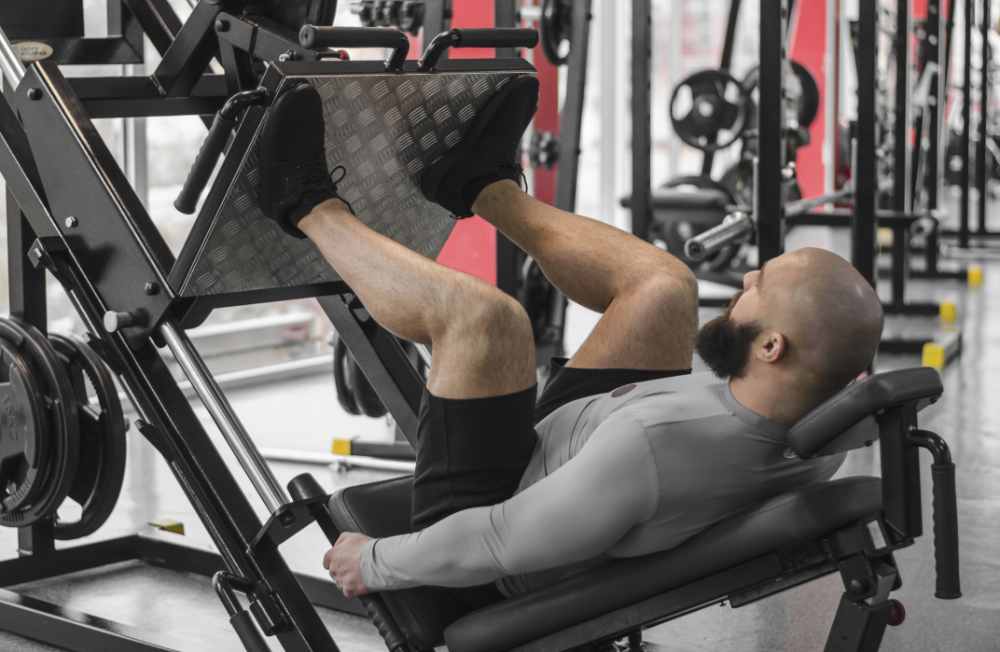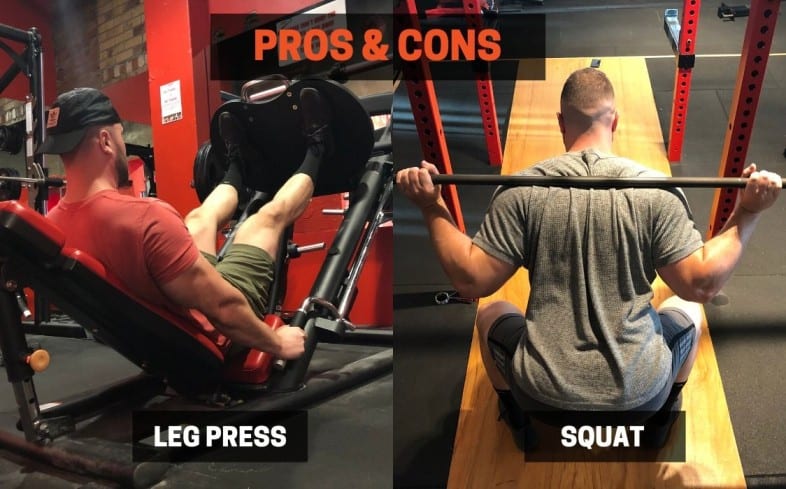Have you ever wondered how you can take your leg strength to the next level after doing squats? Well, have I got a solution for you! Have you ever heard of incorporating the leg press exercise into your routine? If not, you’re in for a treat!
In this article, we’re going to delve into the benefits of incorporating the leg press exercise after squats. Not only will you learn how it can maximize your leg strength, but also how to do it properly to get the most out of your workout.
So, let’s talk about the benefits of adding the leg press to your leg routine. First and foremost, the leg press is a fantastic exercise for targeting your quadriceps, hamstrings, and glutes.
By doing squats followed by leg press, you’re engaging those leg muscles even more, leading to increased strength and muscle development. Additionally, the leg press allows you to lift heavier weights than you might be able to with squats alone.
This added resistance can help you build more overall leg strength. But don’t worry, we’ll get into the specifics of how to do the leg press exercise properly in the next section. Stay tuned to make the most out of your leg day!

Benefits of Incorporating Leg Press After Squats
Increased muscle activation
When you perform squats, you primarily target the quadriceps, hamstrings, and glutes. However, by incorporating the leg press after squats, you can further activate these muscles and recruit additional muscles such as the calves and hip adductors. The leg press allows you to focus on specific leg muscles, providing a targeted and intense workout that stimulates growth and strength development.
Enhanced overall leg strength
By combining squats and leg press, you engage both the anterior and posterior muscle groups of the legs, resulting in overall leg strength development. Squats primarily target the quadriceps and glutes, while the leg press mainly targets the quadriceps, hamstrings, and calves. Together, these exercises create a synergistic effect, leading to increased leg strength and power.
Improved muscular endurance
Leg press after squats can also help improve your muscular endurance, which is crucial for activities that require repetitive leg movements, such as running or cycling. By pushing your legs to their limits during the leg press exercise, you train your muscles to endure fatigue and maintain performance for longer periods. This can be especially beneficial for athletes or individuals participating in endurance sports.

How to Properly Perform Leg Press After Squats
To get the most out of your leg press after squats, it is essential to perform the exercise with proper form and technique. Here’s a step-by-step guide to help you get started:
Step 1: Set up the leg press machine
Adjust the seat of the leg press machine to a comfortable position. Ensure that your back is fully supported and aligned with the machine’s backrest. Set the foot platform at an appropriate height for your leg length and flexibility. Make sure the weight stack is properly loaded and secured.
Step 2: Position yourself correctly
Sit on the leg press machine with your back pressed firmly against the backrest. Place your feet shoulder-width apart on the foot platform, with your toes pointing slightly outward. Your knees should be in line with your toes. Grab the side handles of the machine for stability.
Step 3: Adjust the weight and foot placement
Choose an appropriate weight that allows you to perform the exercise with proper form and without compromising your technique. Place your feet high on the foot platform to target the quadriceps and glutes, or lower on the foot platform to target the hamstrings and calves. Experiment with different foot placements to find what works best for you.
Step 4: Perform the exercise with proper form
Push through your heels and extend your legs, fully straightening your knees without locking them. Avoid rounding your lower back or lifting your hips off the seat. Lower the weight under control by bending your knees, allowing them to flex until your thighs are parallel to the foot platform or slightly lower. Repeat for the desired number of repetitions.
Recommended Leg Press Variations
To add variety to your leg training and target different muscles, here are some recommended leg press variations to try:
Single-leg leg press
By performing the leg press with one leg at a time, you engage each leg individually, promoting balance and symmetry. This variation also places greater demand on the stabilizing muscles of the hips and core. Start with a lighter weight and gradually increase as you build strength and stability.
Wide stance leg press
Widening your foot placement on the leg press machine targets the inner thigh muscles (adductors) to a greater extent. This variation can help develop overall leg size and strength, particularly in the inner thigh area. Be mindful of maintaining proper form and avoid excessive inward knee tracking.
Narrow stance leg press
Bringing your feet closer together on the foot platform shifts the focus to the outer thigh muscles (abductors) and places greater emphasis on the quadriceps. This variation can help improve quad development and create more definition in the front of your thighs. Take caution not to place undue stress on your knees and maintain control throughout the movement.

Precautions and Safety Measures
It is important to keep safety in mind as you incorporate the leg press after squats into your leg training routine. Here are some precautions and safety measures to consider:
Consult with a professional trainer or coach
If you’re new to the leg press exercise or have any underlying health conditions, it is advisable to seek guidance from a qualified professional. They can assess your fitness level, teach you proper form, and provide modifications based on your individual needs and limitations.
Start with lighter weights and gradually increase
Regardless of your experience level, it’s always best to start with lighter weights and gradually increase as your strength and technique improve. This approach allows your muscles, joints, and connective tissues to adapt to the new stress placed upon them, reducing the risk of injury.
Maintain proper breathing technique
During the leg press exercise, remember to breathe properly to ensure adequate oxygen supply to your muscles. Inhale as you lower the weight and exhale as you push the weight up. Avoid holding your breath, as it can increase intra-abdominal pressure and contribute to improper form.
Listen to your body and avoid overexertion
Pay attention to any warning signs such as pain, discomfort, or excessive fatigue during or after the leg press exercise. Pushing beyond your limits or ignoring pain can lead to injuries. If something doesn’t feel right, modify the exercise, reduce the weight, or consult with a health professional.
Tips for Maximizing Leg Strength with Leg Press After Squats
To get the most out of incorporating leg press after squats and maximize your leg strength, consider the following tips:
Include leg press in your leg training routine
Make leg press a regular part of your leg training regimen to ensure consistent progress and well-rounded leg development. By combining it with squats, you create a comprehensive workout that targets various muscle groups from different angles.
Progressively increase the intensity and volume
As you become more comfortable with the leg press exercise, gradually increase the intensity and volume of your workouts. This can be done by adding more weight, increasing the number of sets and repetitions, or adjusting the tempo and range of motion. Keep challenging your muscles to promote continuous adaptation.
Properly warm up before the workout
A thorough warm-up is essential before engaging in any exercise, including the leg press after squats. Start with a few minutes of light cardio activity to increase blood flow to the muscles and prepare them for the upcoming workout. Follow it with dynamic stretches and mobility exercises targeting the lower body.
Allow adequate rest and recovery
Give your leg muscles enough time to recover and repair between leg training sessions. Overtraining or not allowing for sufficient recovery can hinder progress and increase the risk of injury. Aim for at least 48 hours of rest between intense leg workouts to optimize muscle growth and prevent overuse injuries.
Common Mistakes to Avoid
To optimize your leg training and minimize the risk of injury, be mindful of the following common mistakes when incorporating leg press after squats:
Using excessive weight
One of the most common mistakes is using too much weight, compromising form and technique. It is crucial to select a weight that allows you to maintain proper form throughout the exercise. Start with a weight that challenges you but still enables controlled movements. As you progress, incrementally increase the weight while ensuring good technique.
Using momentum instead of controlled movements
Often, people tend to rely on momentum to move the weight during the leg press exercise rather than focusing on controlled, deliberate movements. This not only reduces the effectiveness of the exercise but also increases the risk of injury. Instead, concentrate on maintaining a slow and controlled tempo throughout the entire range of motion.
Neglecting proper form and technique
Maintaining proper form and technique is paramount for optimizing results and preventing injury. Avoid rounding your lower back, lifting your hips off the seat, or allowing your knees to collapse inward. Focus on maintaining proper alignment, engaging the correct muscles, and moving through a full range of motion.
Skipping warm-up and stretching
Skipping the warm-up and neglecting to stretch before the leg press exercise can increase the risk of muscle strains or other injuries. Take the time to properly warm up your muscles, increase blood flow, and perform dynamic stretches that target the muscles used during the leg press.
Potential Risks and Limitations
While leg press after squats can provide significant benefits and help maximize leg strength, there are potential risks and limitations to be aware of:
Risk of injury if performed incorrectly
Performing the leg press with improper form, using excessive weight, or not paying attention to your body’s warning signs can increase the risk of injury. It is important to seek guidance from a qualified professional and practice proper technique to minimize the risk of harm.
Not suitable for individuals with certain medical conditions
Individuals with pre-existing knee, hip, or lower back injuries or conditions may need to avoid or modify the leg press exercise to prevent exacerbating their condition. It is always best to consult with a medical professional or physical therapist if you have any concerns or specific limitations.
May not be effective for everyone
While the leg press after squats can be an effective exercise for many individuals, it may not produce the same results for everyone. Each person’s body responds differently to various exercises, and some individuals may find other exercises more suitable or beneficial for their leg strength goals. It is important to listen to your body and adjust your training accordingly.
Scientific Research and Studies on Leg Press After Squats
Scientific research and studies have investigated the effectiveness of incorporating leg press after squats. One study published in the Journal of Strength and Conditioning Research examined the muscle activation patterns during the leg press exercise after squats.
The researchers found that combining squats with the leg press exercise led to increased muscle activation in the quadriceps, hamstrings, and glutes compared to performing squats alone. This suggests that incorporating the leg press after squats can provide additional stimulus to these muscles and potentially enhance leg strength development.
Another research study published in the International Journal of Sports Physiology and Performance investigated the impact of leg press after squats on muscular strength. The study found that participants who performed a combination of squats and leg press experienced greater improvements in lower body strength compared to those who solely performed squats. These findings support the notion that incorporating the leg press after squats can be an effective strategy for maximizing leg strength.
Success Stories and Testimonials
Many individuals have incorporated leg press after squats into their leg training routine and achieved positive results. Here are a few real-life success stories and testimonials:
- Sarah, an amateur powerlifter, noticed significant strength gains in her squat and deadlift after adding leg press to her training. She credits the leg press exercise for improving her quad strength and stability, leading to better overall leg performance.
- Mark, a recreational runner, found that incorporating leg press after squats helped him build muscular endurance, allowing him to run longer distances without experiencing as much muscle fatigue in his legs.
- Jessica, a fitness enthusiast, struggled with imbalances in her leg muscles. By incorporating single-leg leg press into her routine, she was able to address these imbalances and achieve more symmetrical leg development.
- John, a former athlete recovering from a knee injury, worked with a physical therapist to modify the leg press exercise to suit his individual needs. Through progressive rehabilitation and leg press training, he was able to regain strength in his injured leg and return to his favorite sports.
Conclusion
Incorporating the leg press after squats can be a valuable addition to your leg training routine, allowing you to maximize leg strength and achieve your fitness goals. By following proper technique, gradually increasing intensity, and taking necessary precautions, you can reap the benefits of increased muscle activation, enhanced leg strength, and improved muscular endurance.
Remember to consult with a professional, start with lighter weights, and listen to your body to prevent injury and optimize your leg training. With consistency, dedication, and the incorporation of leg press after squats, you can unlock your full leg potential and take your leg strength to new heights. So, why wait? Get ready to show off your strong and powerful legs!




